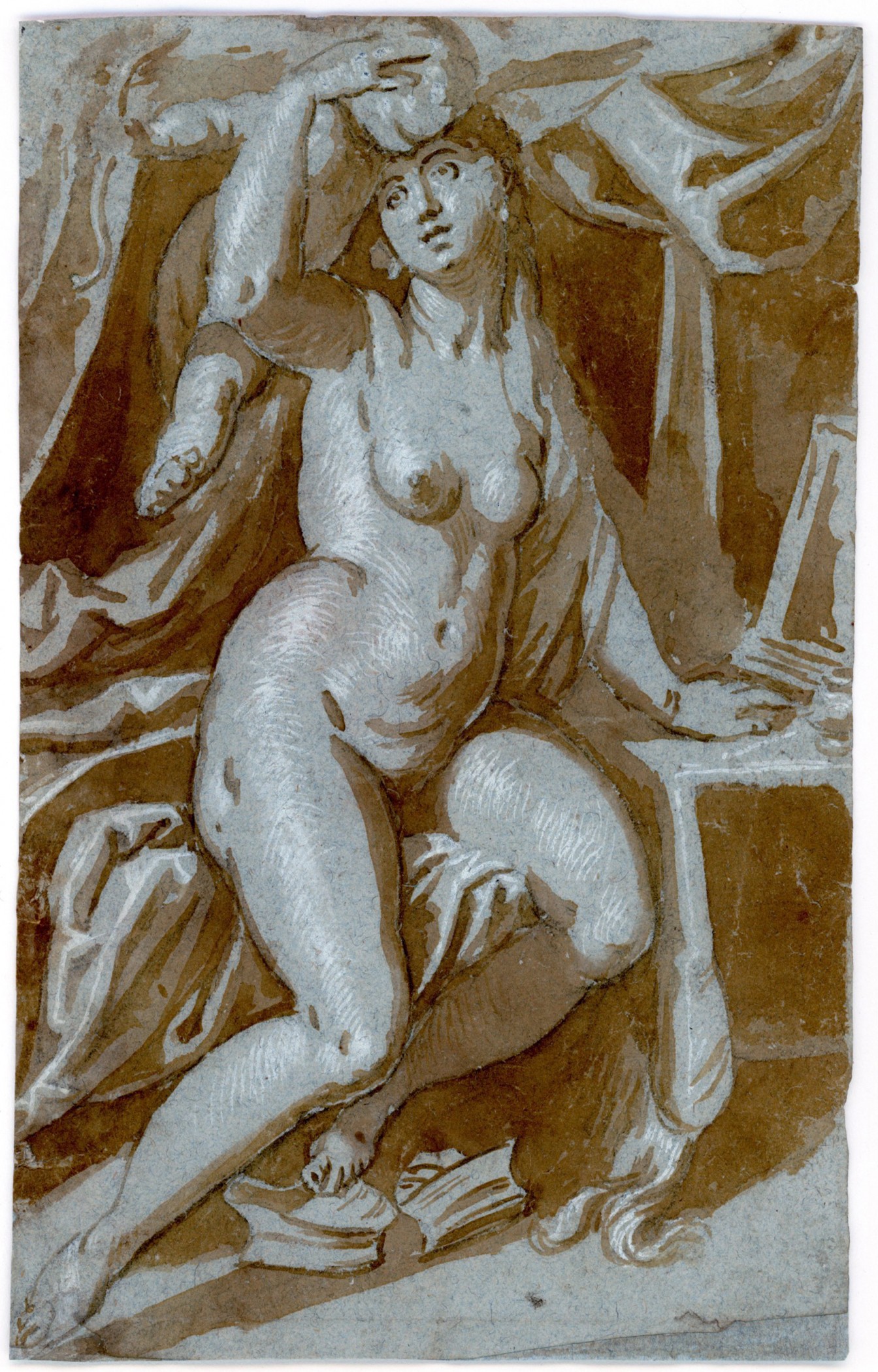Cherubino Alberti
(Borgo Sansepolcro, 1553 - Rome, 1615)
Venus and Cupid
pen and brush, brown ink, enlightened in white, on prepared paper
224 x 141 mm (88.19 x 55.51 inches)
Cherubino Alberti
(Borgo Sansepolcro, 1553 - Rome, 1615)
Venus and Cupid
pen and brush, brown ink, enlightened in white, on prepared paper
224 x 141 mm (88.19 x 55.51 inches)
Re: 0265
Provenance: Zaccaria Sagredo Borghese, Venice
Description:Venus is shown crouched on a seat covered by a broad canopy, her hand resting on a ledge on which we see a mirror and a small jar of unguents, when she is surprised from behind by Cupid, who kisses his mother gently on the forehead.
The stamp “G. P. no. 12” (Lugt 2103a) on the back of the drawing tells us that it comes from the ‘Album Sagredo – Borghese’, a vast collection of drawings owned by the Sagredo family of Venice, many of which once formed part of the collection belonging to that illustrious Procurator of St. Mark’s Zaccaria Sagredo (1653 - 1729)[1]. The drawing’s original ownership provides implicit confirmation of its excellence, testifying to the subtly erotic mood that took hold in the figurative arts, and in our case in the depiction of mythology, throughout Europe in the final decades of the 16th century and on into the first twenty years of the 17th. One of the capitals of this taste in European culture, alongside Prague at the time of the Emperor Rudolf II, was unquestionably the Rome of Pope Clement VIII Aldobrandini (1592 – 1605). Numerous masters representing a broad range of styles flocked to the papal capital, many of them ending up working on the same projects, which spawned some very successful instances of stylistic cross-contamination. The artist who benefited the most from what he learned in the city, to the point where he was to become the painter of choice in the projects patronised by the Pope himself, was without any doubt Cherubino Alberti, the artist to whom we can attribute this drawing[2].
Born in Borgo Sansepolcro in 1553 and arriving in Rome while still an adolescent, Cherubino Alberti trained with his brother Giovanni in the workshop of Dutch painter and engraver Cornelis Cort. Coming into contact with the masters of the Raphaelesque tradition and, perhaps more importantly, with the figurative repertoire of Classical art, he was prompted to embark on a long career as a draughtsman and engraver of mythological subjects at a time when such items had regained a certain popularity in Rome, after a brief period in the 1560s and ‘70s when they had fallen out of fashion[3]. An excellent yardstick by which to judge this drawing is a famous etching by Alberti depicting the Birth of Venus in which – as indeed in this drawing – we can clearly detect the influence of Michelangelo’s robust female nudes and, of course, of Raphael’s Galatea in the Villa Chigi[4]. Where Alberti’s output as a draughtsman is concerned, in those rare drawings in which he used a brush (given that the majority of his graphic work consisted of rapid sketches with a pen) his skill in using lead white highlights to bring out his figures’ powerful sculptural quality emerges quite clearly, a practice he developed through seeking to transfer onto paper the reliefs of Classical sculptures whose subjects, for example on the front of sarcophagi, he frequently copied with meticulous care[5]. This Venus, built around a rapid movement of the hips that underscores the goddess’s vibrancy, is clearly inspired by images of her carved in the Hellenistic age, their rediscovery during excavations in the Forum area and their subsequent acquisition by the most prestigious Roman collectors of the day offering Alberti the chance to pursue his detailed study of such models from life, so to speak.
An echo of the figure’s pose can be seen in the allegorical images painted by the two Alberti brothers on the walls of the great hall in Palazzo Ruggieri in Rome[6] – particularly the figure of Peace painted by Cherubino on the left-hand wall: thus a date close to that commission, c. 1590, appears to be the most likely date for this drawing.
[1] For the Sagredo family’s collection of drawings, see the relevant passages in Cristiana Mazza’s book: C. Mazza, I Sagredo committenti e collezionisti d’arte nella Venezia del Sei e Settecento, Venice 2004.
[2] For Pope Clement VIII Aldobranini’s commissions to Cherubino and Giovanni Alberti, see: M. C. Abromson, Clement VIII’s patronage of the brothers Alberti, in “The art bulletin”, LX, 1978, pp. 531-547; S. Macioce, Per un’introduzione al pontificato di Clemente VIII Aldobrandini (1592-1605): politica e committenza, in “Bollettino della Deputazione di Storia Patria per l’Umbria”, CX!, 2014, II, pp. 709-726.
[3] For the Alberti, see: C. Witcombe, Giovanni and Cherubino Alberti, College degree diss., Bryn Mawr (Pennsylvania.) 1981; A Matteoli, entry Alberti, in Saur. Allgemeines Künstlerlexicon. Die Bildenden Künstleraleer Zeiten und Völker, II, Munich 1992, pp. 69-71.
[4] Prints of the engraving are to be found in numerous museums; in this case we are referring to a print in the Museum of Art in Philadelphia (inv. 1985-52-7865)
[5] For Cherubino Alberti as a draughtsman, see: K. Herrmann Fiore, Studi sui disegni di figure di Giovanni e Cherubino Alberti, in “Bollettino d’arte”, LXV, 1980, 5, pp. 39-64; Disegni degli Alberti: il volume 2503 del Gabinetto Nazionale delle Stampe, e. Herrmann Fiore, exhibition catalogue (Rome, Gabinetto Nazionale delle Stampe, Villa alla Farnesina alla Lungara, 25 November 1983 – 2 January 1984), Rome 1983.
[6] M. V. Brugnoli, Un palazzo romano del tardo ’500 e l’opera di Giovanni e Cherubino Alberti a Roma, in “Bollettino d’arte”, XLV, 1960, pp. 233.246; S. Hoppe, Der Buon Governo des Pompeo Ruggieri. Die Fresken von Cherubino und Giovanni Alberti im Palazzo Ruggieri in Rom, PHD Diss., Saarbrücken 2015, I, pp. 96-101.

